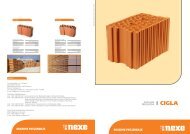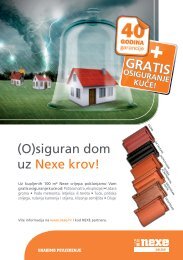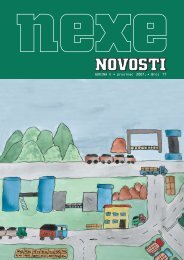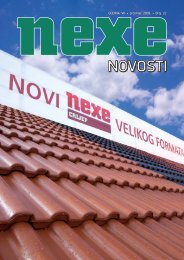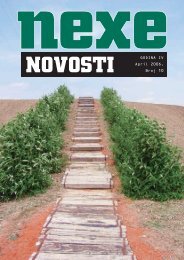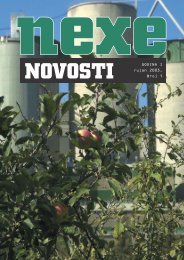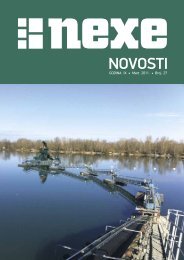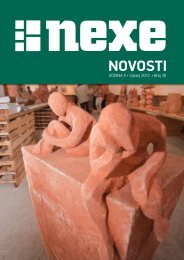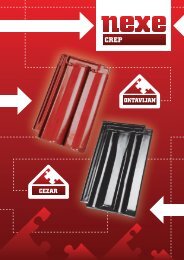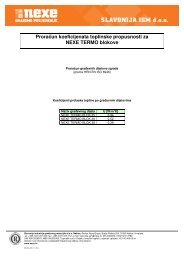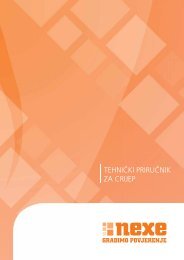You also want an ePaper? Increase the reach of your titles
YUMPU automatically turns print PDFs into web optimized ePapers that Google loves.
LIME<br />
<strong>Jelen</strong> <strong>Do</strong>
The production of lime in <strong>Jelen</strong> <strong>Do</strong> started way back<br />
in 1928. Initially, lime was produced in primitive clamp<br />
kilns, but later, when the operation became a part of<br />
Belgrade-based Ratko Mitrović Construction Company,<br />
several coal-fired shaft-type kilns were built and the<br />
production was modernized. Owing to the exceptional<br />
quality of the basic raw material (lime from Suvo <strong>Do</strong><br />
and Grabovik opencasts in <strong>Jelen</strong> <strong>Do</strong>) and modernized<br />
production, <strong>Jelen</strong> <strong>Do</strong> soon won reputation as a producer<br />
of one of the highest-quality limes in former Yugoslavia.<br />
Today, operating within Nexe Group, <strong>Jelen</strong> <strong>Do</strong> continues<br />
modernizing its equipment and technology, permanently<br />
improving the quality of its range of products in order<br />
to maintain and enhance its reputation among consumers,<br />
fully satisfying all of their demands.<br />
Our lime has a high content of CaO and Ca(OH)2.<br />
The following types of lime are available:<br />
• unslaked lump lime (0 - 63mm, 0 - 150mm)<br />
• unslaked ground lime (0 - 5mm)<br />
• unslaked micronized lime (0 - 90μm)<br />
• bulk hydrated industrial lime<br />
• hydrated lime packed in bags (25kg) and<br />
palletized (a pallet weighs 1,250kg and is<br />
covered with a protective foil)
UNSLAKED LUMP LIME<br />
Properties:<br />
Owing to the above properties, lime can be used:<br />
IN NON-FERROUS METALLURGY<br />
In the process of copper flotation, lime is used as a<br />
depressant and for achieving the desired level of<br />
alkalinity in flotation tanks. Similarly, unslaked lump<br />
lime is used in flotation of lead ores, zinc and nickel<br />
and in separation of mercury (where it is used for<br />
removal of sulfur), gold and silver.<br />
Lime is also used for neutralization of sulfur dioxide<br />
which is released during melting and refinement of<br />
copper, zinc, lead and other ores. It is done in such<br />
way that the gas in the purifier flows through lime<br />
milk, which prevents creation of sulfuric acid and its<br />
release into the atmosphere.<br />
Lime milk is also used in refining of nickel (after<br />
melting, nickel settles in a solution of boiling lime<br />
milk), while lime water is used in refining of copper.
IN FERROUS METALLURGY:<br />
Having completed the gasification of its production<br />
plants, <strong>Jelen</strong> <strong>Do</strong> can now offer a new product - metallurgy<br />
lime adapted for use in different phases of steel production<br />
(in desulphurization and refinement, as a melting agent)<br />
for three basic purposes:<br />
1. Production of crude cast iron from iron ore.<br />
2. As a melting agent in blast-furnaces and converters,<br />
where, reacting with SiO2, phosphorus, sulfur and, to a<br />
lesser extent, manganese, it removes these contaminants<br />
from steel; the by-product of the process is slag, which<br />
can be removed.<br />
3. in secondary refinement of steel and in manufacturing<br />
of steel products.<br />
The lime from our quarries has very little admixtures<br />
that have adverse effect on the quality of steel<br />
(alkalis, sulfates,...) and gas-fired calcination eliminates<br />
the possibility of admixtures of sulfur occurring in lime.<br />
Properties of lime:<br />
PROPERTY JELEN DO AD<br />
CaO CONTENT<br />
MgO CONTENT<br />
CALCINATION LOSS<br />
SiO2<br />
R2O3<br />
P<br />
Sulfide sulfur S<br />
94,50<br />
up to 2%<br />
2,09<br />
0,18<br />
0,31<br />
/<br />
0,00<br />
SRPS B.B6.023/1981<br />
I class<br />
Min.90%<br />
Max.2,0%<br />
Max.5<br />
Max.1,5%<br />
Max.1,5%<br />
Max.0,04%<br />
Max.0,04%<br />
SRPS B.B6.023/1981<br />
II class<br />
Min.87%<br />
Max.2,5%<br />
/<br />
Max.2,5%<br />
Max.2%<br />
Max.0,06%<br />
Max.0,06%
IN CONSTRUCTION INDUSTRY:<br />
Lump lime is used for making of slaked lime, which is<br />
then used as a binder in making of mortar.<br />
GROUND AND MICRONIZED LIME<br />
Unslaked ground lime is used for removal of silicates<br />
from bauxite ore in production of alumina, from which<br />
aluminum is then extracted.<br />
Unslaked micronized lime is used as a raw material for<br />
production of aerated concrete and silica brick.<br />
Temperature, C<br />
90<br />
80<br />
70<br />
60<br />
50<br />
40<br />
30<br />
20<br />
10<br />
0<br />
Lime-slaking curve<br />
1 2 3 4 5 6 7 8<br />
Time, min<br />
9 10 11 12 13 14 15<br />
The reactivity of lime can be modified according to<br />
specific demands of customers.
HYDRATED LIME<br />
PROPERTIES:<br />
PROPERTY JELEN DO AD SRPS B.C1.020/1981<br />
CaO CONTENT 71.38<br />
MgO CONTENT 2.67<br />
CONTENT OF ACTIVE CaO AND MgO 93.73<br />
CALCINATION LOSS 25.25<br />
FREE WATER AT 120 0.42<br />
BOUND WATER 22.29<br />
SiO2 + UNSOLUBLE RESIDUE 0.20<br />
RESIDUE ON 0.6mm SIEVE<br />
0.00<br />
RESIDUE ON 0.9mm SIEVE<br />
7.40<br />
STABILITY OF VOLUME<br />
stable<br />
not defined<br />
Max. 8%<br />
Min. 85%<br />
Max. 27%<br />
Max. 5%<br />
not defined<br />
not defined<br />
Max 0.00%<br />
Max 10%<br />
stable<br />
The above specified properties make hydrated lime<br />
useful not only in construction industry, but also in:<br />
• decarbonization<br />
(it binds the Mg and Ca bicarbonates and<br />
carbonates from water)<br />
• PH regulation of water<br />
(it neutralizes acidic waters which contain excessive<br />
quantities of CO2 and are aggressive to plumbing)<br />
• purification of drinking water<br />
• in fishponds<br />
(for burning of surplus organic matter, disinfection<br />
of pond bottom and pond water and PH regulation<br />
of water)<br />
• purification of waste waters<br />
(sewer and industrial waters)<br />
• sanitization of the sites of various ecological<br />
incidents<br />
(neutralization of hazardous waste)<br />
• soldification etc.<br />
In addition to its traditional use in construction industry<br />
(as a binder in the making of mortar, as well as for<br />
production of machine mortar, facades and lime putty),<br />
which is still very common, lime is now used more and
more in preparatory works for stabilization of ground.<br />
Numerous studies have shown that the use of lime as<br />
a component of mortar is indispensable for long-term<br />
high-quality living conditions, which is particularly<br />
important for plastering interior walls. The recipe for<br />
mortar depends on its specific use. We recommend that<br />
the following proportion among the basic components<br />
be maintained when they are mixed:<br />
LIME MORTAR<br />
VOLUME SHARE OF<br />
COMPONENTS<br />
HYDRATED<br />
LIME<br />
CEMENT SAND<br />
Basic 1 3<br />
Final 2 3<br />
CEMENT-LIME MORTAR<br />
VOLUME SHARE OF<br />
COMPONENTS<br />
HYDRATED<br />
LIME<br />
CEMENT SAND<br />
Basic 2 1 6<br />
Final 3 1 9<br />
Brick-laying mortar 2 1 9<br />
It is also important to emphasize that there is a widespread<br />
and growing trend of environmental-friendly<br />
construction in the world today, which implies returning<br />
to traditional methods of building that include<br />
traditional, natural materials. Lime is one of the oldest<br />
building materials and is fully made of natural components,<br />
with no additions. The evidence for its usefulness<br />
can be found in the fact that it has been used for<br />
centuries.<br />
Since the content of harmful and hazardous materials<br />
in lime (lead, arsenic, barium, fluorides) is far below the<br />
allowed maximum, lime can also be used in food industry<br />
for water treatment.
<strong>Jelen</strong> <strong>Do</strong> a.d. <strong>Jelen</strong> <strong>Do</strong><br />
31215 <strong>Jelen</strong> <strong>Do</strong>, Serbia<br />
Phone:<br />
Switchboard: +381(0)31/590-599<br />
Sales dept: +381(0)31/590-564, 590-502, 590-572<br />
Fax:<br />
Switchboard: +381(0)31/590-570<br />
Sales dept: +381(0)31/590-560<br />
office@jelendo.co.yu<br />
www.jelendo.co.yu<br />
November 2007, 1000 copies



